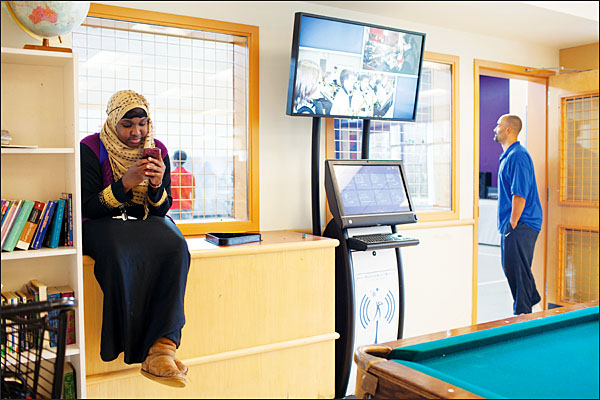Students’ Lack of Home Internet Access Becomes Priority for District Tech Leaders

By guest blogger Leo Doran
After winning the battle to expand the federal E-rate program, education leaders are beginning to look beyond the struggle of connecting all schools to high quality Internet, and toward the next challenge of connecting all students while outside of school.
The Consortium for School Networking, or CoSN, issued a plan of action this week that aims to prod district leaders to at least gather data on personal student broadband access.
The report, which calls the matter an issue of “civil rights,” indicated that 75 percent of school district leaders have no data on their students’ Internet access outside of school, while 70 percent of teachers nationally report assigning homework that requires access. The report goes on to outline steps districts can take to leverage existing assets and programs to increase off-campus connectivity.
Keith Krueger, CEO of CoSN, said that in the wake of a collective national shift over recent decades to online learning as “the way we do education,” now is the critical moment “to get serious about ubiquitous access.”
“It’s like sending some kids home without a textbook,” said Laura Hansen, director of information management at Metro Nashville Public Schools, illustrating how Internet equity can exacerbate achievement gaps.
The Tennessee district is in the process of implementing a far-reaching blended learning program, but the effort has met roadblocks in recent years as teachers reported high numbers of students unable to take advantage of online resources.
Hansen said the stakes are high for getting families access as well, since student feedback and parent-teacher engagement are increasingly delivered online.
For district leaders interested in tackling the problem, the “action toolkit” released by CoSN includes a sample survey for students and parents to help officials get a better understanding of the challenges facing their particular district.
The survey, produced by the Friday Institute for Educational Innovation at N.C. State in partnership with CoSN, is meant to replace existing tools that Krueger said “aren’t nuanced enough” because they don’t accurately reflect students struggling with spotty connections or shared devices.
Once data have been gathered, Krueger encourages district leaders to coordinate with local governments, engage community businesses, and take careful stock of existing assets to formulate a plan of action.
Existing solutions highlighted in the report include districts that mapped local businesses offering free Wi-Fi, districts that outfitted school buses with wireless routers, and districts that promoted subsidized broadband programs for low-income families.
Among one of the more ambitious potential solutions highlighted in the report is an effort underway in Albemarle County, Va. to repurpose the Educational Broadband Service spectrum. which is allocated by the Federal Communications Commission, and reserved for schools to deliver access. The spectrum was originally set aside for educational radio and TV broadcasts, but goes unused in many districts nationally.
At the federal level, momentum has been building to update the FCC’s Lifeline program, which currently subsidizes telephone service and expand the subsidies to cover broadband Internet, while a report issued by President Obama’s Broadband Opportunity Council in September highlighted efforts already underway.
In supporting these efforts, Krueger stressed the importance of a sustained focus on the problem from the local level up, saying that a failure to address the status quo “disadvantages those that are already economically disadvantaged.”
Photo: Fatuma Shoka, a 9th grader at Auburn Mountainview High School, uses the wireless Internet at the Birch Creek Community Center. The center, through a program supported by the Kent, Wash., school district, offers a kiosk emitting free Wi-Fi so students can go online to complete their school assignments.—Matthew Ryan Williams for Education Week
See also:
- E-Rate Undergoing Major Policy, Budget Upgrades
- Panel Calls for FCC to Offer Broadband Subsidies to Low-Income Households
- US Ed-Tech Plan Calls Attention to ‘Digital-Use Divide’
Follow @BenjaminBHerold and @EdWeekEdTech for the latest news on ed-tech policies, practices, and trends.

One thought on “Students’ Lack of Home Internet Access Becomes Priority for District Tech Leaders”